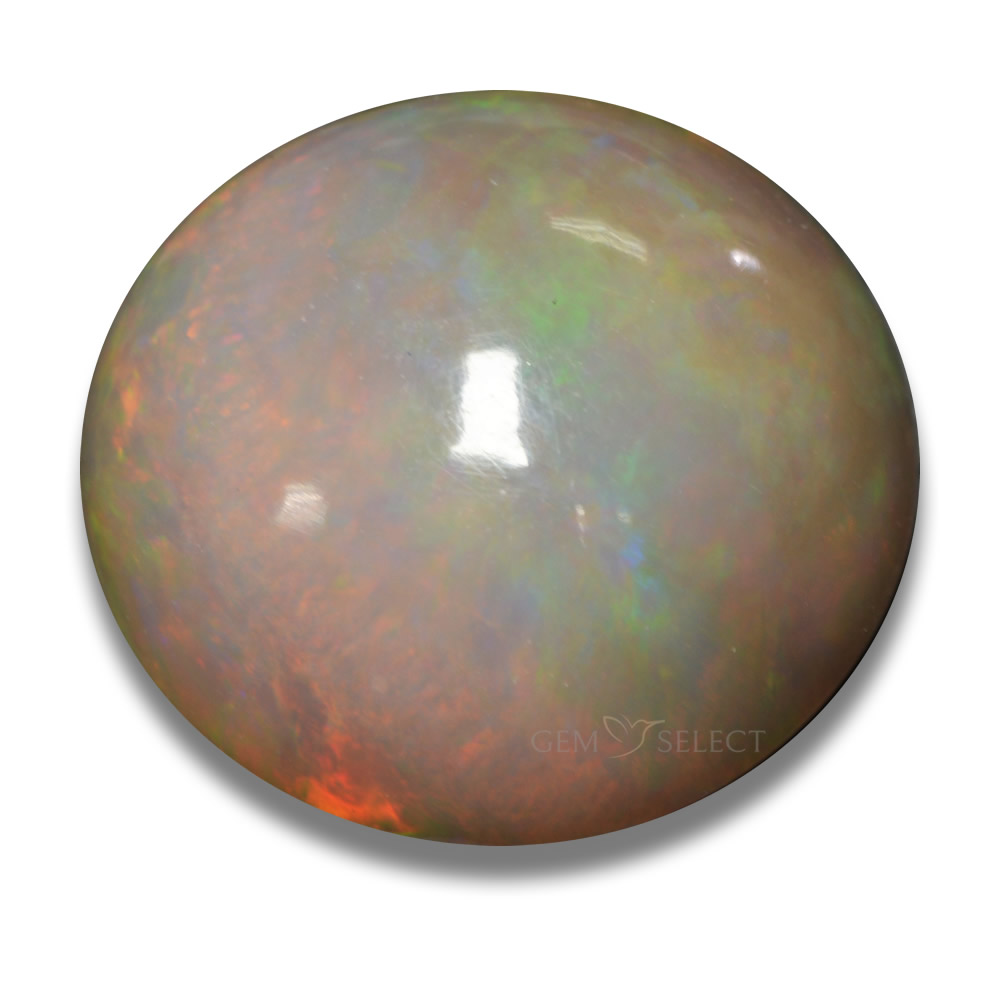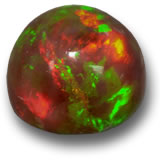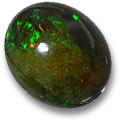Chocolate Opal Gemstone Information

About Chocolate Opal – History and Introduction
Chocolate Opal captivates with its distinctive brown tones and enchanting display of colors, making it a gemstone of unique appeal. For those looking to add a touch of elegance to their jewelry collection, Chocolate Opal is a fantastic choice. In this article, we'll dive into everything you need to know about Chocolate Opal, from its origins and symbolism to fun facts, properties, and more.
Back in 1939, British anthropologist, archaeologist, and naturalist Louis Leakey suggested that opal mines existed in ancient Africa. He based this on tools he found made from opal materials during his explorations in Kenyan caves. Later, these artifacts were dated back to around 4000 B.C. - pretty mind-blowing, right?
Then, in 1994, geologist Dr. N. Barot confirmed Leakey's ideas after seeing Ethiopian opals traded in Nairobi. This sparked Telahun Yohannes to start searching for Ethiopian opal. Yohannes pioneered the mining efforts, putting Ethiopia on the map as a major opal producer and the exclusive source for Chocolate Opal.

Identifying Chocolate Opal
Chocolate Opal is one of many opal varieties out there. What sets it apart is its signature chocolate-brown base color, ranging from light to dark shades. The darker backgrounds really make the play of color pop, which is the key feature that makes precious opal so special. No other gem can mimic that magical, shifting color effect you see in Chocolate Opal.
Just a quick note: People sometimes misuse "opalescence" to describe this play of color, but technically, it refers to common opal (or "potch") that doesn't show any color play at all.
Chocolate Opal Origin and Gemstone Sources
Chocolate Opal forms in volcanic environments, nestled in layers of volcanic ash as clusters of nodules. Despite its fiery appearance, it develops at relatively low temperatures compared to other volcanic rocks.
This gem is exclusively mined from Yita Ridge, about 150 miles northeast of Ethiopia's capital, Addis Ababa. The opal fields stretch along the northern side of the ridge, covering just a few square miles near Mezezo. Because of this limited area, Chocolate Opal is quite rare, with supply being tight.
Other opal types come from places like the United States, Czech Republic, Slovakia, Turkey, Hungary, Indonesia, Honduras, Guatemala, Nicaragua, and Brazil. In a wild twist, NASA found opal deposits on Mars in 2008! Australia dominates the market, producing over 90% of the world's high-quality opal.
Buying Chocolate Opal and Determining Chocolate Opal Gemstone Value
Chocolate Opal Color
Ethiopian opal stands out from others, and some experts say Chocolate Opal is among the most striking, especially with strong color play and snakeskin patterns. The best pieces show vivid flashes across the spectrum, including rare turquoise and indigo hues not seen in Australian opals.
Chocolate Opal Clarity and Luster
Chocolate Opal ranges from translucent to opaque, with rare semi-transparent finds. It has a waxy luster that enhances its color play. Most pieces have some internal fractures or crazing, but as long as they're not too severe, it doesn't hurt the value much.
Chocolate Opal Cut and Shape
It's usually cut into round or oval cabochons, but fancy shapes like trillions or hearts are popular too. Crack-free cabochons fetch top prices. Ethiopian Chocolate Opal from Amhara Province is famed for its fire and hydrophane traits - meaning it can absorb water and change appearance, which is kinda cool.
Chocolate Opal Treatment
Some Ethiopian opals get smoked to darken their color, sold as "Ethiopian black opal" - a budget-friendly alternative to Australian black opal. True Chocolate Opals are generally untreated, though some opals might be stabilized with wax or resin, but that's uncommon for this variety.
Chocolate Opal Gemological Properties
| Chemical Formula: | SiO2_nH2O Hydrous silicon dioxide |
|---|---|
| Crystal Structure: | Amorphous |
| Color: | All colors, play of color |
| Hardness: | 5.5 - 6.5 on the Mohs scale |
| Refractive Index: | 1.37 - 1.52 |
| Density: | 1.98 - 2.50 |
| Cleavage: | None |
| Transparency: | Opaque, translucent to transparent |
| Double Refraction: | None |
| Dispersion: | None |
| Pleochroism: | None |
Chocolate Opal Gemstone Varieties or other Similar Gemstones

Opal comes in many forms, split into "precious" (with color play) and "common" (without). It can be confused with ammonite, labradorite, mother-of-pearl, or moonstone, but tests easily tell them apart. Precious opal sometimes layers with common opal or chalcedony, sold as "opal doublets." "Opal triplets" add a protective crystal layer. For detailed information on opal varieties and properties, explore further.
Most Popular Opal Varieties:
Black opal, chocolate opal, boulder opal, fire opal, white opal, opal in matrix, and opal doublet top the list.
Lesser Known Opal Varieties:
Jelly opal, crystal opal, harlequin opal, opal triplets, layer opal, agate opal, angel skin opal, wood opal, honey opal, hyalite opal, hydrophane opal, porcelain opal, moss opal, girasol, prase opal, wax opal, and pipe opal are rarer finds.
Chocolate Opal Gemstone Mythology, Metaphysical and Healing Powers
The word "opal" comes from the Sanskrit "upala," meaning "valuable stone," evolving through Greek and Latin terms related to color change.
An Australian Aboriginal legend says the creator descended on a rainbow, bringing peace, and where his foot touched, stones sparkled to life as opals.
Opal has long been linked to healing in various cultures. Believers say it combats depression and helps in love matters. Since the Middle Ages, it's been called the "eye stone" for aiding vision and eye health issues. As October's birthstone, it's thought to bring benefits to wearers.
Disclaimer: Metaphysical and Alternative Crystal Healing Powers and Properties are not to be taken as confirmed medical advice. Should you have any medical conditions, please see a licensed practitioner. This information is not to replace the advice of your doctor and GemSelect does not guarantee any claims or statements made. GemSelect cannot be held liable under any circumstances.
Chocolate Opal Gemstone and Jewelry Design Ideas
Opting for loose gemstones over preset jewelry lets you verify quality firsthand - settings can hide flaws. Plus, you get more choices and better deals.
Even though it's delicate, Chocolate Opal works great in rings (cabochon style), pendants, earrings, brooches, and pins. For men, it's masculine enough for cufflinks or tie-tacks. Its color range pairs with any metal, but go for sturdy settings to keep it safe.
Chocolate Opal Gemstone and Jewelry Care and Cleaning

Opals are delicate due to their water content - they can dry out if not stored right, leading to cracks. Keep them in a sealed bag with a damp cloth to maintain moisture. They're soft (5.5-6.5 on Mohs), so avoid scratches from dust (which has quartz).
Clean with a soft cloth and room-temperature water; skip chemicals, bleach, or ultrasonic cleaners. Remove jewelry before chores or sports. If damaged, replacement might be easier than repair, as fixes like resin impregnation are experimental. Check out these essential tips for caring for opals to keep your gems in top condition.
Frequently Asked Questions
What is Chocolate Opal?
Chocolate Opal is a variety of opal known for its brown base color and vibrant play of colors, sourced exclusively from Ethiopia.
Where is Chocolate Opal found?
It's mined only from Yita Ridge in Ethiopia, making it quite rare.
How can I identify genuine Chocolate Opal?
Look for the distinctive chocolate-brown base with intense color flashes; no other gem replicates its play of color.
Is Chocolate Opal often treated?
Some are smoked to enhance color, but untreated pieces are common. Always ask about treatments when buying.
How should I care for Chocolate Opal jewelry?
Store in a moist environment, clean gently with water and a soft cloth, and avoid extreme temperatures or chemicals.

